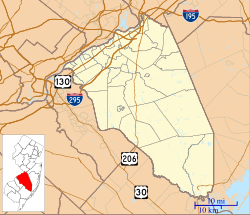New Jersey Manual Training and Industrial School for Colored Youth | |
 | |
| Location | N of Burlington Rd., W of I-295, Bordentown, New Jersey |
|---|---|
| Coordinates | 40°8′29″N 74°43′25″W / 40.14139°N 74.72361°W |
| Area | 97 acres (39 ha) |
| Built | 1903 |
| Architect | Guilbert and Betelle; Charles N. Lowrie |
| Architectural style | Colonial Revival |
| NRHP reference No. | 97001563[1] |
| Added to NRHP | January 5, 1998 |
The Bordentown School (officially titled the Manual Training and Industrial School for Colored Youth, the State of New Jersey Manual Training School and Manual Training and Industrial School for Youth, and referred to by other names) was a residential high school for African-American students in Bordentown in Burlington County, New Jersey, United States. Operated for most of the time as a publicly financed co-ed boarding school for African-American children, it was known as the "Tuskegee of the North" for its adoption of many of the educational practices first developed at the Tuskegee Institute in Alabama.[2] The school closed down in 1955.
- ^ "National Register Information System". National Register of Historic Places. National Park Service. March 13, 2009.
- ^ Keyes, Allison. "Documentary Focuses On 'Tuskegee Of The North'", National Public Radio, May 24, 2010. Accessed June 8, 2010.


